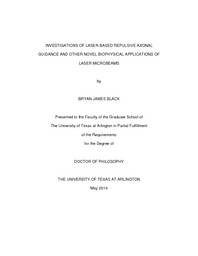
ATTENTION: The works hosted here are being migrated to a new repository that will consolidate resources, improve discoverability, and better show UTA's research impact on the global community. We will update authors as the migration progresses. Please see MavMatrix for more information.
Show simple item record
| dc.contributor.author | Black, Bryan James | |
| dc.date.accessioned | 2017-05-31T19:24:08Z | |
| dc.date.available | 2017-05-31T19:24:08Z | |
| dc.date.submitted | January 2014 | |
| dc.identifier.other | DISS-12694 | |
| dc.identifier.uri | http://hdl.handle.net/10106/26686 | |
| dc.description.abstract | Over the past 30 years, the properties of light have been increasingly exploited to probe and manipulate biological samples. The subsequent techniques and technologies, combined with the broadening optical characterization of biological samples (from cells to single molecules), have had a revolutionary impact on the fields of biophysics, bioengineering, chemistry, and molecular biology. Light is now known to be capable of manipulating biological samples with high spatial and temporal precision, and minimal invasiveness. Herein, we offer the findings of several novel, light-based studies as well as novel applications which exploit a laser microbeam as either a potential gradient, a cutting tool, or a temperature gradient. Chapter 1 is divided into two main sections. One will describe the fiber-optic spanner, a novel optical tool which enables the rotation of whole cells as well as micromotors using light emitting from two counterpropagating single-mode optical fibers with a transverse offset between them. Detailed simulations of the optimal fiber orientation (separation, transverse offset, etc.) as well as stability analysis are provided. The second section will offer experimental confirmation of a newly-developed multi-scale analysis model for dynamical motion of a microsphere entering an optical trap. Chapter 2 will describe two applications of light as a cutting tool. By creating a transient hole on the surface of a cellular membrane, we have successfully introduced rhodamine phalloidin into primary rat cortical neurons. Second, we demonstrate femtosecond laser-mediated axotomy in order to study the extent of degeneration and regeneration pathfinding ability of goldfish retinal ganglion cell axons in the presence and absence of estrogen. A subsequent study reveals that various degrees of initial injury caused by laser axotomy may heavily influence the regeneration pathfinding ability. Chapter 3 will demonstrate the novel application of a weakly focused laser micro-beam as a repulsive guidance cue for primary central nervous system axons (both retinal ganglion cell as well as rat cortical axons). Since this method does not require that the light impinge directly upon the axon (or growth cone), we hypothesize that the powerful, at-a-distance effect is due the temperature field (or gradient) produced by absorption of light by the environment. A detailed investigation of the temperature field hypothesis is carried out and our findings heavily implicate temperature effects as the primary repulsive guidance mechanism. This text and figures included in this thesis draw heavily from published works (1-5) as well as my Master's thesis (Applications of Laser Microbeam in the Study of Degeneration, Regeneration, and Guidance of Primary CNS Axons, not currently published), which I (Bryan Black) am primary or secondary author, and principle experimental contributor. Special care is taken to reference the contributions of other authors. As the publication of our theses is required as a matter of school policy, I make it now known that no perceived duplicate or redundant claim to my contributions in any field is intended. | |
| dc.description.sponsorship | Mohanty, Samarendra | |
| dc.language.iso | en | |
| dc.publisher | Physics | |
| dc.title | Investigations Of Laser-based Repulsive Axonal Guidance And Other Novel Biophysical Applications Of Laser Microbeams | |
| dc.type | Ph.D. | |
| dc.contributor.committeeChair | Mohanty, Samarendra | |
| dc.degree.department | Physics | |
| dc.degree.discipline | Physics | |
| dc.degree.grantor | University of Texas at Arlington | |
| dc.degree.level | doctoral | |
| dc.degree.name | Ph.D. | |
Files in this item
- Name:
- Black_uta_2502D_12694.pdf
- Size:
- 4.705Mb
- Format:
- PDF
This item appears in the following Collection(s)
Show simple item record


